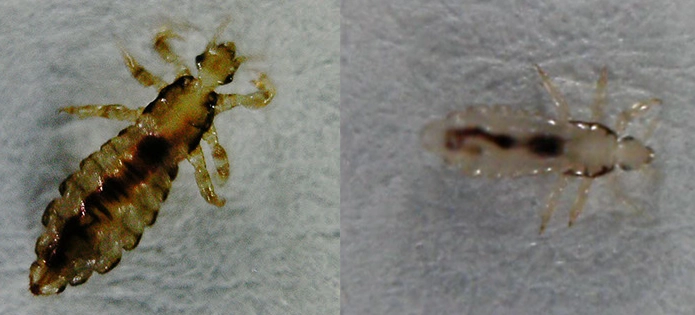What are head lice?
Head lice, which are minuscule insects that extract blood from the human scalp, predominantly affect children. These bugs usually spread via direct contact when hair from one person comes into contact with the hair of another.
Life Cycle of Lice
Understanding the life cycle of a louse is essential to effectively treating and preventing infestations. The life cycle of a louse has three stages: egg (nit), nymph, and adult.
Egg (Nit) Stage:
- Lice eggs or nits are laid near the scalp and are yellow or white in color.
- Nits are tiny and less than one millimetre in size.
- Nits take about 8-9 days to hatch but can take longer in cooler temperatures.
- Empty eggshells remain attached to the hair shaft after hatching and can be used to identify an infestation.
Nymph Stage:
- Lice hatch from eggs and enter the nymph stage.
- Nymphs look like adult lice but are smaller and lighter in color.
- Nymphs moult three times before reaching adulthood.
- Nymphs require a blood meal within a few hours of hatching.
- Nymphs take 9-12 days to mature into adults.
Adult Stage:
- Adult lice are sesame seed-sized, have six legs, and are tan to greyish-white in color.
- They can live up to 30 days on a human host and require a blood meal every 3-6 hours.
- Adult females lay up to 8 nits per day starting about a week after hatching.
- An adult female can lay up to 240 eggs during her 30-day lifespan.
It's important to note:
- Lice cannot survive for long away from a human host and can't reproduce on objects like combs or bedding.
How to tell if you have lice?
Some indications that someone may have head lice differ from person to person.
The presence of live lice in the hair is a clear sign of infestation. These tiny insects can move quickly and are often difficult to spot, but a severe case may reveal many crawling bugs.
These are the tiny, oval-shaped eggs that lice lay on hair shafts close to the scalp. They can be difficult to see and may look like dandruff or hair spray droplets, but they cannot be easily removed from the hair.
Itching can be a sign of head lice. But not everyone itches from lice. The itching is a reaction to the lice biting the scalp. Itching can last for several days after treatment until the bites heal.
How do lice spread?
The most common way that head lice are spread is from person to person through crawling.
Crawling
Lice have strong claws that make it easy for them to cling to human hair.
This means that when two people come into close contact, the lice can easily crawl from one head to another.
Environment
Although possible, it is not common to get lice from the environment since lice cannot live for long without a host to feed on. The most likely way to get lice from the home is through direct contact with someone infested, as lice may fall off one person and crawl onto another
Lice do Not:
- Jump: Lice do not have knees therefore they can not jump.
- Fly: Head lice do not have wings.
Lice Prevention
Now that you know more about lice and how lice spread, here are some simple steps you can take to avoid infestations altogether:
Avoid Head-to-head contact:
Head lice are great at crawling on hair, avoid head-to-head contact with people who have lice, especially in group settings like schools, camps, and sports activities.
Keep hair up:
Encourage children to keep their hair tied back or up in a bun or ponytail to reduce the risk of contact with lice.
Use product:
You can use products that help keep the hair close to the scalp. Products like hair spray, mousse or hair gel.
Use Lice Preventatives:
Use lice-repellent products to prevent infestations. Special shampoos and conditioners have been formulated with essential oils that lice find unappealing.
When using these products, be sure to follow the instructions carefully and use them regularly for maximum effectiveness.
Consider incorporating these preventative measures into your routine to help protect yourself and your family from head lice infestations
Get Professional Help
If you're struggling to get rid of head lice, consider seeking professional treatment from Jamie's Lice Angels.
Our experienced team uses safe and effective methods to eliminate head lice and their eggs.
At Jamie's Lice Angels, we understand how frustrating and overwhelming head lice infestations can be. That's why we're committed to providing compassionate and effective treatment options for our clients.
Don't let head lice disrupt your life any longer. Contact Jamie's Lice Angels today to schedule an appointment and take the first step towards a lice-free future.
Get Treatment Today!
Are you ready to be done dealing with head lice? Call now to schedule an appointment with Jamie!
- Answer All Questions
- Go Over Head Lice Treatment Options
- Prepare You For Treatment
- Schedule Appointment
- Receive Peace of Mind
Content: source:cdc.gov
